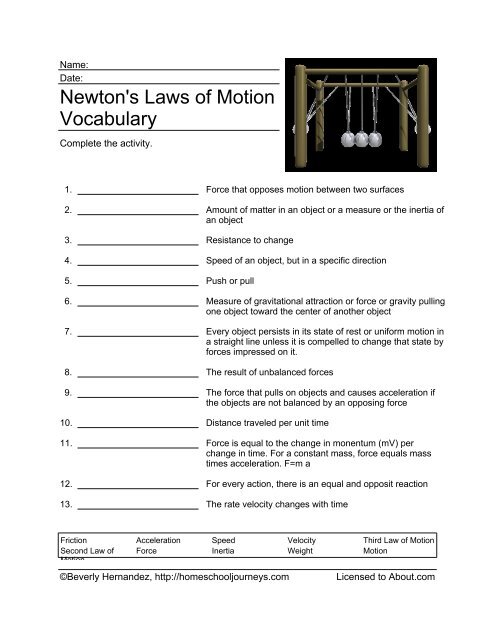
Newton's Second Law of Motion defines the relationship between acceleration, force, and mass. This law represents a certain symmetry in nature: forces always occur in pairs, and one body cannot exert a force on another. Newton's third law: If an object A exerts a force on object B, then object B must exert a force of equal magnitude and opposite direction back on object A. This is a concept generally called inertia. This remarkable fact is a consequence of Newton's third law. You could also say that an object will maintain constant velocity unless affected by an outside force, as velocity accounts for both speed and direction. Newton's First Law of Motion states that in order for the motion of an object to change, a force must act upon it. Subsequent action by either house may also be included in a schedule. Newton’s First Law of Motion Newton’s First Law states that an object will maintain a constant speed and direction unless affected by a net outside force. Newton’s own laws of motion would be modeled on this Cartesian breakthrough, as is readily apparent in Descartes’ first two laws of nature: the first states that each thing, as far as is in its power. Schedules of amendments list amendments agreed to by the second house are communicated to the first house for consideration. Foremost among the achievements of Descartes’ physics are the three laws of nature (which, essentially, are laws of bodily motion). For details about the outcome of proposed amendments please refer to either the Votes and Proceedings (House of Representatives) or the Journals (Senate). It supersedes the explanatory memorandum.Ĭirculated by members and senators when they propose to make changes to the bill. Revised explanatory memorandum: Accompanies and explains the amended version (third reading) of the bill.Supplementary explanatory memorandum: Accompanies and explains amendments proposed by the government to the bill.Explanatory memorandum: Accompanies and provides an explanation of the content of the introduced version (first reading) of the bill.

Usually, the reference frame is the Earth. The laws describe only the motion of a body as a whole and are valid only for motions relative to a reference frame.

Third reading: Prepared if the bill is amended by the house in which it was introduced. Lesson 4: Newton’s Laws of Motion 4.1 Newton’s First and Second Laws 4.2 Newton’s Third Law 4.3 Reference Frames 4.4 Non-inertial Reference Frames Lesson 5: Gravity 5.1 Universal Law of Gravitation 5.2 Worked Example: Gravity Superposition 5.3 Gravity at the Surface of the Earth: The Value of g.First reading: Text of the bill as introduced into the Parliament.


 0 kommentar(er)
0 kommentar(er)
